Friday Night Unplugged #19.2: Runewars Play Report
- Updated: 21st Apr, 2013
It’s week 2 of our epic Runewars two-particle. Last week I looked at its upsides, its downsides and spent a little time considering whether you should rush out and throw money in its general direction. This week myself and Fi slogged it out in a two-player game to bring you a play report, plus our final opinions.
Rather than detail each individual turn, action, draw and choice we decided to take a route similar to our Eclipse play report. Runewars is played over an in game time of seven years each split into seasons and we’ll be recapping each year as it passes rather than each turn. First a quick recap of how each turn works.
Rules Recap:
- At the beginning of each round a season card is revealed ( following the Spring, Summer, Autumn Winter cycle)
- That card is resolved and the players take actions based on the rules text and that cards symbols. You’ll be retrieving played Order cards in spring, questing in summer, gaining influence in autumn and the have the ability to move across the sea borders in winter.
- Once the Season card has resolved each player picks and lays face-down an order card from their hand.
- Orders include harvesting resources, recruiting new units, gaining influence, moving and attacking areas and moving runes around friendly areas.
- Orders are resolved in order of which players order has the highest number value printed on it. Supremacy bonuses are granted for having the highest total value between order cards in play.
- After all orders have been played out, it moves to combat. Combat is done using the Fate deck of cards and is quick and simple to work out. Injured or routed units are laid on their side and whoever has the most points of stood units left on the battlefield wins the combat. The losing side retreats into a friendly or empty neighbouring space.
- Dragon runes are placed face down in pairs. One is blank on the underside and the other has a rune icon. This means there are always more tokens on the board then there are actual runes. Players can look at tokens under their control but keep them hidden from other players.
Setup:
We’ve set up the game for a basic two-player scenario. Fi is playing as the Latari Elves and I’m taking control of the human Daqan Lords. Heroes, starting quests and objectives have all been set up and all soldiers, both neutral and otherwise, are on the board.
The goal is either to control the most dragon runes at the end of the game’s seven-year cycle, or to control six runes and resolve that race’s victory card (we’ll get to this when it happens). Of course dragon runes are randomly placed and some are actually blank so it’ll take a keen memory to remember what runes are where. Who’ll emerge victorious in Terrinoth? Let’s find out.
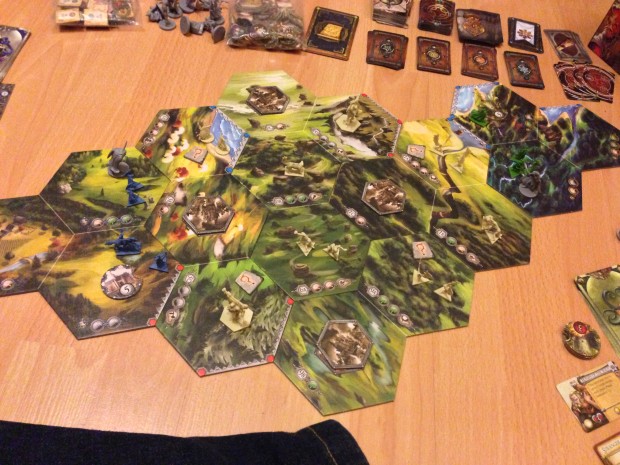
A basic two-player map of Runewars setup for play. The Daqan Lords are the blue minis on the left with the Latari Elves the green on the right.
The First Year:
The gods of the seasons were kind in our first year of war. Spring granted us all a second batch of fresh troops. The Latari with Fi at their head marched their way into the easterlands, forcing a group of Razorwings to flee in terror. Thanks to the timing of the extra harvest this year the Daqan were able to bolster their lands with the help of an extra recruit order, seizing three regions for their own and defeating a giant in the process. The questing stage of the summer passed by fairly quickly with both heroes completing their first quests and each drawing a Timmoran shard from the reward deck. These can be handed in at their home stronghold to place extra dragon runes on the board.
Winter allowed me the choice of losing resources to place extra dragon runes on the board. Having not used my harvest order yet I decided I could take the early runes now and harvest in the beginning of the following spring.
The Second Year:
The second year of the war was long. For the most part myself and Fi spent it bolstering our positions, recruiting new troops and securing new lands. We both took the chance during summer to exchange our shards for new rune tokens on the board. During the autumn a small band of elves pushed deeper into the west and after a victorious fight against the same group of Razorwings that had fled beforehand, the elves were annoyingly close to my line of defence. Fi won the influence bid that was drawn at the start of winter as I wasn’t prepared to spend the single influence I had left, netting herself a card from the reward deck and drawing yet another Timmoran shard. Other than the mass of dragon runes on the board, all was quiet in Terrinoth in the second year of the war.
The Third Year:
The third year passed as the first and second had. Starting with a recruit order in the spring, the summer was where things got interesting. Neither me nor Fi seemed awfully interested in questing this season, instead opting for the military might tactic. After all, it worked in Eclipse. Fi recruited more units while I sent a large mob of foot-soldiers straight for the least protected rune token she controlled. After a bloody battle the elves were forced into retreat and I had control of the rune token. Autumn and winter saw the Latari scrambling together new resources from a harvest order while I swapped the rune token in the area Fi had previously controlled for one of the blank ones I controlled before quickly scampering back to the closest friendly area to regroup.
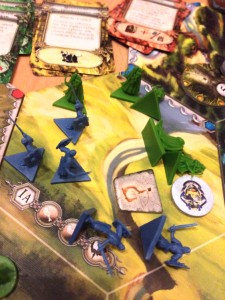
The battle of Runewater saw many proud Elves and Lords alike fall but I was left in control of the last vital rune token.
The Fourth Year:
During the spring of the fourth year of war, in an attempt to lure me into a trap Fi swapped two of her rune tokens with a fortify action; one from deep within her home realms was swapped with a city. My only chance of winning the game quickly would be to take another rune token from her. The Daqan stuck with their guns. They launched an attack on the city and were now in control of the six rune tokens needed for victory. The Daqan victory card was placed on the spring pile and will resolve in its place on the next spring.
In the summer the Latari recruited new units for the cause while I moved my new dragon token towards my defensive line. Knowing that the game would not end if she could take back one of my now-revealed rune tokens before the next spring, Fi launched an attack on the closest token. With four of her men either injured or routed and only two of mine injured thanks to my siege tower, the Latari were forced into retreat. With only the winter remaining Fi decided to cut her losses and gather resources from a harvest. With my last order I recruited new units to replace those just routed.
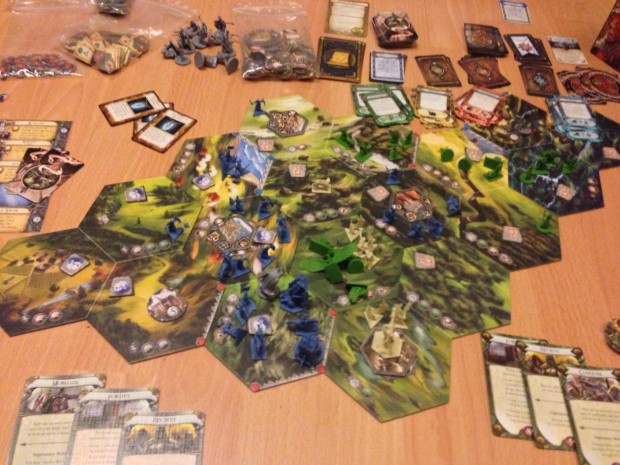
The endgame board-state was awash with blue and green but the dragon runes remained firmly under the protection of the Lords.
The Fifth Year:
In the spring of the fifth year of the great war of runes the Daqan Lords brought peace to the land of Terrinorth. The Latari put up a good fight but bad hands dealt by fate proved it was not meant to be. The Daqan victory card resolved as I still controlled six dragon runes, ending the game.
What Just Happened:
That was a fairly fast game for Runewars. The fact it was two players certainly helped and some ridiculous draw luck from the reward stack kept things moving in the usually slow early stages.
Final Word:
Runewars has some cool stuff going for it. The lands are small and encourage combat, rune tokens allow for hidden information and the Order mechanic is cool and simple to use. Unfortunately, after a few games we still feel like it could do more. Each race plays pretty much the same and there are no major differences between the seasons other than the actions you can take afterwards.
With most games going long due to the amount of time it takes to resolve each season there just isn’t enough variety to keep interest if you’re not a massive strategy game lover. If strategy games are your thing and you love the idea of pushing troops around a fantasy world, dominating giants and fighting dragons then Runewars is definitely a game I’d recommend. You can pick it up for £49.99 over at Amazon.
Next Week:
Next week we’re stepping into one of the most anticipated games we’ve played here at FNU Towers. Mice and Mystics is a storytelling/rpg/miniatures/adventure game from Plaid Hat Games and has gained almost unanimous praise across the tabletop industry. Is it as good as we’re expecting? Come back and find out.

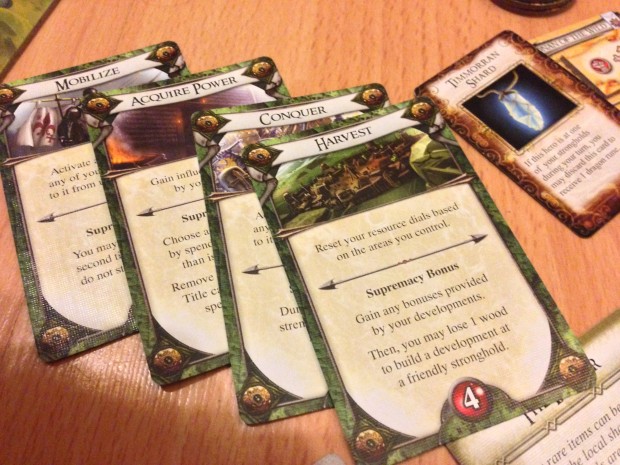
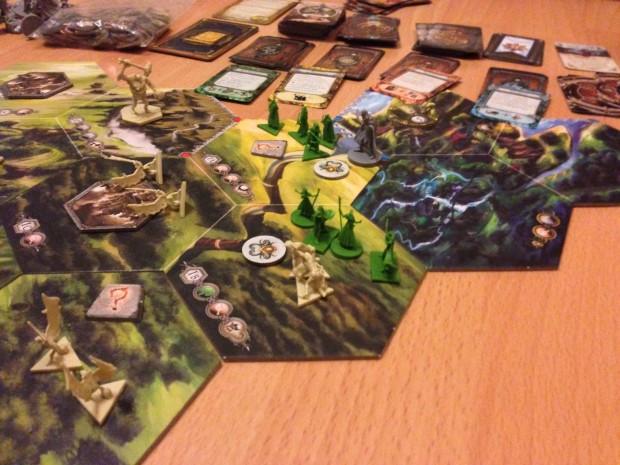
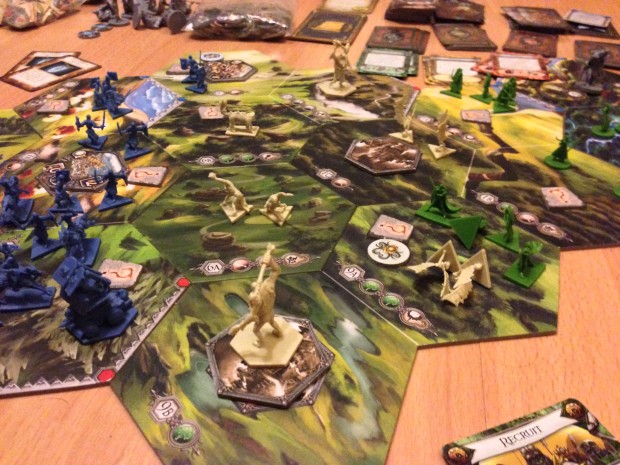
Follow Us!